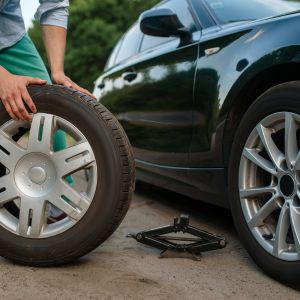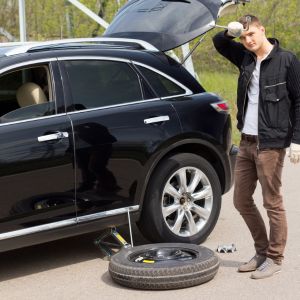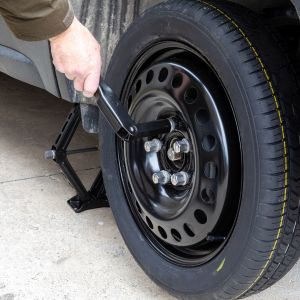A spare tyre is an extra tyre that is carried in a vehicle as a backup in case one of the regular tyres becomes damaged or punctured. It is typically smaller and less durable than the regular tyres, and is not meant for long-term use. Spare tyres are usually found in the trunk of a car or in a compartment under the vehicle. Now. we’ll discuss about how to safely drive on a spare tyre.
They are designed to be used temporarily until a damaged tyre can be repaired or replaced. Spare tyres are usually a “Temporary Use Only” tyres, and it’s not recommended to drive more than a few miles on a spare tyre and replace it with a new tyre as soon as possible.
How to safely drive on a spare tyre?

Driving on a spare tyre can be dangerous if not done correctly. Here are some tips to safely drive on a spare tyre:
- Check the tyre’s inflation: Before driving on a spare tyre, it is important to check the tyre’s inflation and make sure it is at the proper pressure. Underinflated or overinflated tyres can cause poor handling and increase the risk of an accident.
- Drive at a reduced speed: Spare tyres are not meant for long-term use and may not provide the same level of traction, stability, and handling as a regular tyre. It is important to drive at a reduced speed, especially on wet or slippery roads.
- Avoid sudden turns or braking: Spare tyres have a smaller diameter than regular tyres, which can make the vehicle more difficult to handle. It is important to avoid sudden turns or braking, to avoid causing further damage to the tyre or increasing the risk of an accident.
- Avoid long-distance travel: Spare tyres are typically smaller than regular tyres and are not designed for long-term use. It is not recommended to drive more than a few miles on a spare tyre and replace it with a new tyre as soon as possible.
- Check the spare tyre’s condition: Before you set out on your trip, check the condition of the spare tyre. If the tyre is visibly damaged, such as cuts, punctures, sidewall bulging, or excessive wear, it is not safe to drive on and should be replaced immediately.
- Check the car’s manual: Always check the car’s manual for the manufacturer’s recommendations for using a spare tyre. Some vehicles have specific guidelines for using a spare tyre, and it’s important to follow them for your safety and the safety of others on the road.
It’s important to note that a spare tyre is a temporary solution and it’s not designed for long-term use, it’s highly recommended to replace the spare tyre with a new one as soon as possible to ensure your safety and the safety of other drivers on the road.
When to use a spare tyre?

A spare tyre should be used when one of the regular tyres on a vehicle becomes damaged or punctured and cannot be safely driven on. This can happen due to a flat tyre, a blowout, or a car puncture. When this happens, it is important to pull over and replace the damaged tyre with the spare tyre as soon as possible to ensure the safety of the vehicle and its occupants.
It is also important to note that spare tyres are typically smaller and less durable than regular tyres and are not meant for long-term use. They should only be used temporarily until the damaged tyre can be repaired or replaced with a new one.
It’s important to check the spare tyre’s condition before using it and make sure that it is properly inflated, if you find any damage on the spare tyre, such as cuts, punctures, sidewall bulging, or excessive wear, it is not safe to drive on and should be replaced immediately.
Driving on a spare tyre for an extended period of time can compromise the safety of the vehicle and it’s highly recommended to replace the spare tyre with a new one as soon as possible to ensure your safety and the safety of other drivers on the road.
How to inflate a spare tyre?

To inflate a spare tyre, you will need an air compressor or a manual tyre pump. Follow these steps:
- Remove the spare tyre from the vehicle and locate the valve stem on the tyre.
- If using an air compressor, attach the nozzle to the valve stem and turn on the compressor. If using a manual pump, attach the pump to the valve stem.
- Inflate the tyre to the recommended pressure, which can be found on the sidewall of the tyre or in the vehicle’s owner’s manual.
- Use a tyre pressure gauge to check the pressure and adjust as needed.
- Once the tyre is properly inflated, reattach it to the vehicle and make sure it is securely fastened.
Note: Check your spare tyre is the correct size for your vehicle and that it is in good condition before using it.
Frequently Asked Questions
Q1. Is it safe to drive around on a spare tyre?
Ans: It’s not recommended to drive on a spare tyre for an extended period of time as spare tyres are usually smaller and not meant for long-term use. They may not provide the same level of traction, stability, and handling as a regular tyre.
Q2. How fast can you really drive on a spare tyre?
Ans: The maximum speed you can drive on a spare tyre is usually around 50mph.
Q3. Can you drive for 2 weeks with a spare tyre?
Ans: It’s not recommended to drive more than a few miles on a spare tyre and replace it with a new tyre as soon as possible.
Q4. Does the spare tyre need air?
Ans: Yes, the spare tyre needs air and should be checked for proper inflation before use.

